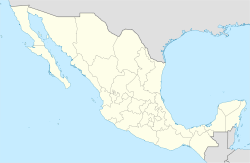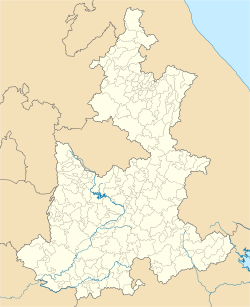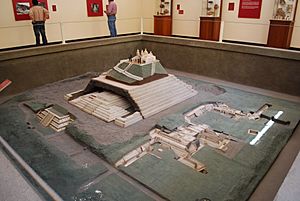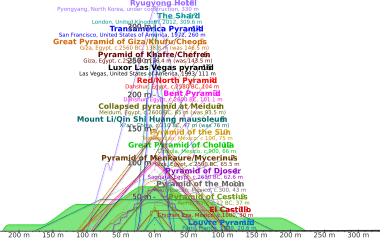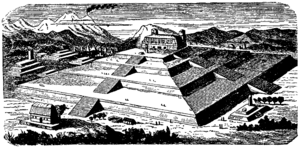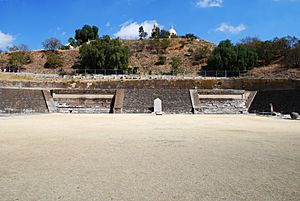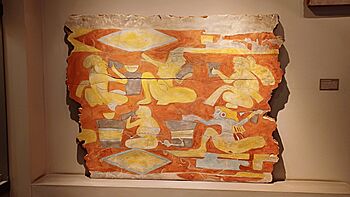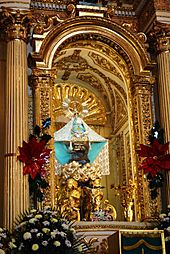Great Pyramid of Cholula facts for kids
 |
|
| Location | Cholula de Rivadabia, Puebla, |
|---|---|
| Region | Puebla |
| Coordinates | 19°03′27″N 98°18′07″W / 19.05750°N 98.30194°W |
| History | |
| Founded | c. 3rd century BC |
| Abandoned | c. 8th century AD |
| Periods | Classic to Postclassic |
| Site notes | |
| Architecture | |
| Architectural styles | Talud-tablero |
| Architectural details | Number of temples: 1 |
| Responsible body: Instituto Nacional de Antropología e Historia | |
The Great Pyramid of Cholula is a huge ancient complex located in Cholula, Puebla, Mexico. In the Nahuatl language, it is called Tlachihualtepetl, which means "man-made mountain."
While it's not as tall as the Great Pyramid of Giza in Egypt, it is the largest pyramid in the world by volume. This means it takes up more space than any other pyramid. Its base is enormous, measuring about 300 by 315 metres (984 by 1,033 ft). The pyramid was built as a temple to honor the god Quetzalcoatl. Its design was influenced by the styles of other ancient cities like Teotihuacan and El Tajín.
Contents
Location and Name
The pyramid is in the city of Cholula, which is about 6.4 kilometres (4 mi) west of the city of Puebla. The name Cholula comes from the Nahuatl word cholollan, meaning "place of refuge." The pyramid's other name, Tlachihualtepetl, or "artificial hill," was given by the Toltec-Chichimec people who arrived in the 12th century. They called it this because they believed it was built by humans, not by gods.
History of the Pyramid
The Great Pyramid was a very important religious center for over a thousand years before the Spanish arrived in the Americas. It wasn't built all at once. Instead, it was constructed in several stages, with new, larger pyramids being built right on top of the old ones. This is how it grew to become the largest pyramid in Mexico by volume.
Early History
Construction of the pyramid complex started around the 3rd century BC and continued until the 9th century AD. The final pyramid has a base of 300 by 315 metres (984 by 1,033 ft) and stands 25 metres (82 ft) tall. The Guinness Book of Records recognizes it as the largest monument ever built in the world. Its total volume is estimated at over 4.45 million cubic meters. That's much larger than the Great Pyramid of Giza, which has a volume of about 2.5 million cubic meters.
At its peak, Cholula was a bustling city with around 100,000 people. However, in the 8th century, the city's population shrank, and the pyramid was abandoned. Even so, it remained a sacred place for the people who lived nearby.
Later History
By the time the Spanish arrived in the 16th century, the pyramid was so overgrown with plants that it looked like a natural hill. In 1594, the Spanish built a church, the Iglesia de Nuestra Señora de los Remedios (Church of Our Lady of Remedies), right on top of the pyramid. This church is still there today and is an important destination for religious pilgrims.
Because the church is a historic monument, the pyramid underneath has not been fully excavated and restored like other pyramids in Mexico.
Exploring the Pyramid's Layers
The Great Pyramid is not just one pyramid, but a series of six structures built on top of one another. Think of it like a giant onion with many layers. Each time a new group of people came to power in Cholula, they would build a new, bigger temple over the old one.
Tunnels and Excavations
In 1931, archaeologists led by Ignacio Marquina began digging tunnels into the pyramid to explore its hidden layers. Over the years, they dug about 8.0 kilometres (5 mi) of tunnels. These tunnels revealed the older pyramids, altars, and walls hidden inside the massive structure.
Today, visitors can walk through about 800 meters of these tunnels. The tunnels are now well-lit passages that allow you to see the different construction stages and some of the amazing artwork found inside.
The Hidden Pyramids
The tunnels helped archaeologists discover the different pyramids inside the hill. Here are some of the most important ones:
- Building B (Pyramid of the Painted Skulls): This pyramid was built between 200 and 350 AD. It is famous for its murals of highly stylized human skulls painted in yellow and red.
- Building C (Pyramid of the Nine Stories): Built between 350 and 450 AD, this pyramid was even larger than the Pyramid of the Moon at Teotihuacan. It had nine stepped levels and stairways on all four sides.
Courtyard of the Altars
On the south side of the pyramid is a large open space called the Courtyard of the Altars. This area was likely used for big, important ceremonies. It is surrounded by platforms and several stone altars. Some of the altars are decorated with detailed carvings, including images of feathered serpents.
The Mural of the Drinkers
One of the most amazing discoveries at Cholula is the Mural of the Drinkers. It was found buried deep inside one of the structures. This mural is one of the longest pre-Columbian paintings ever found in Mexico, measuring 57 metres (187 ft) long.
The mural shows about 110 figures at a lively feast. They are sitting, talking, and drinking from cups and jars. Many experts believe they are drinking pulque, a traditional alcoholic beverage made from the maguey plant. The mural gives us a fascinating look into the ceremonies and daily life of the people of ancient Cholula.
Burials at the Pyramid
Archaeologists have found over 400 human burials around the pyramid. Most of these date from after the pyramid was no longer used as a temple, showing it remained a sacred place for centuries.
Some of the burials were of children, who may have been seen as messengers to the rain god Tlaloc. These discoveries help us understand the religious beliefs and practices of the people who lived there.
The Pyramid Today
Today, the Great Pyramid of Cholula is a popular tourist attraction and an important religious site. The church on top, dedicated to the Virgin of the Remedies, is the patron of the city. Each year on September 8th, thousands of people visit the church to honor the Virgin.
Another important event is the Quetzalcoatl Ritual, held every year on the spring equinox. This festival celebrates the site's ancient roots with traditional music, dancing, and poetry.
The pyramid site includes the tunnels, the excavated ruins on the south side, and a museum. The museum has a model of the pyramid's layers and displays many of the artifacts found during excavations. The image of the church on top of the green, hill-like pyramid, with the Popocatépetl volcano in the background, is one of the most famous views in Mexico.
See also
 In Spanish: Gran Pirámide de Cholula para niños
In Spanish: Gran Pirámide de Cholula para niños
- Cholula Mesoamerican site
- List of tallest structures built before the 20th century
Images for kids


